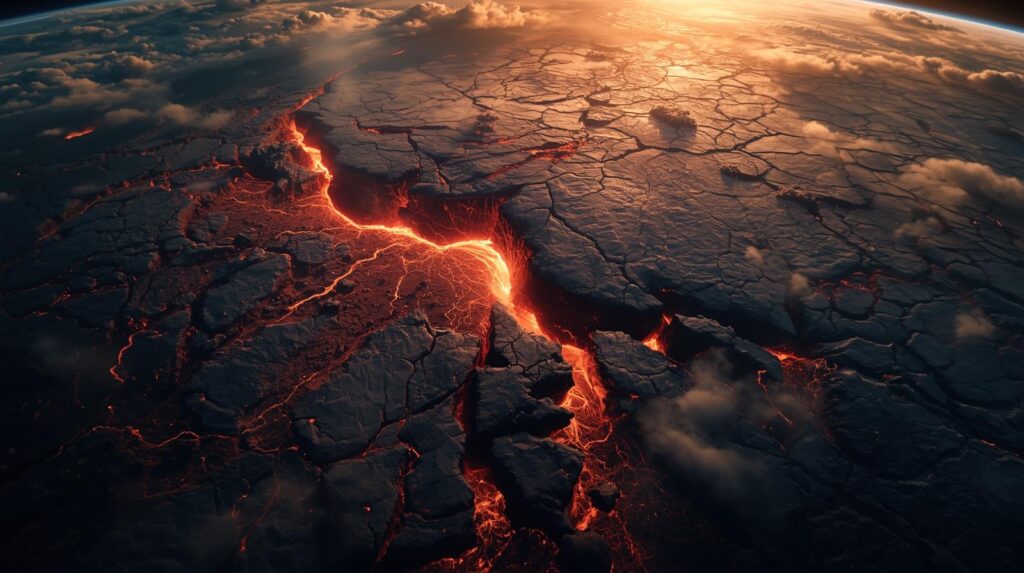Carbon in Earth’s Core: The Hidden Ingredient of Our Planet’s Creation
Ever thought about why Earth is the way it is? Deep beneath our planet, at the blazing, high-pressure core, there is a hidden ingredient: carbon. Scientists think this element, so crucial to life, could be the key to understanding how Earth came to be 4.54 billion years ago. But why is carbon there, and why does it matter?
Carbon is more than the material that constitutes life on the surface of Earth. It also takes a secret role deep within the planet. Buried in the Earth core, carbon influences density, the magnetic field, and melted rocks. Scientists analyze the way carbon is transported under heat and pressure. This informs them about how Earth came into existence billions of years ago. Carbon provides hints about how Earth evolved into a dinosaur-friendly planet
Carbon in Earth’s Core: A Secret Realm
Imagine the Earth as a gigantic, layered onion. At its center, some 2,900 kilometers (1,800 miles) beneath the surface, lies the core—a molten, superhot, dense sphere of predominantly iron and nickel. It is divided into two sections: a solid inner core, approximately 1,220 km (760 miles) in radius, and an encasing liquid outer core, approximately 2,260 km (1,400 miles) thick.
The temperatures there are between 4,400°C and 6,000°C (7,952°F to 10,800°F), hotter than the surface of the Sun! This core is not only a burning furnace; it also produces Earth’s magnetic field, which protects us from dangerous space radiation.
But the center isn’t pure metal. It’s lighter than predicted, and that implies other elements are included. Carbon, together with sulfur, oxygen, silicon, and hydrogen, is a leading contender. Why? They’re common in the universe, can be combined with molten iron, and won’t readily evaporate during the process of building a planet. Carbon, specifically, is of particular interest because it’s vital for life and could be behind mysteries surrounding the density of the core.
How Carbon Ended Up in the Core
To explain carbon’s function, let us trace its history to Earth’s tumultuous birth. Approximately 4.6 billion years ago, the Earth was born from a whirling cloud of gas and dust surrounding the nascent Sun. When pieces of material came together, the Earth turned into a molten sphere.
At this time, a process known as planetary differentiation separated heavier elements, such as iron, to the center to create the core and lighter ones, such as silicates, to create the mantle and crust. This intense episode, also known as the iron catastrophe, occurred roughly 500 million years into Earth’s history when temperatures reached iron’s melting point of 1,538°C (2,800°F).
Carbon, since it readily bonds with iron, most likely got pulled along into the core at this time. Picture iron sinking as dense syrup through a melted Earth, dragging carbon along as a magnet. Laboratory experiments with high-pressure equipment, such as diamond anvil cells, demonstrate that at the ultra-high pressures and temperatures of Earth’s formation (up to 360 gigapascals and 7,000 K), carbon is less likely to remain in the silicate rocks of the mantle and more likely to enter the iron-bearing core. Research indicates the core contains 0.3 to 2.0% weight of carbon, not much but a huge quantity considering the size of the core—possibly 5.5 to 36.8 yottagrams (a number with 24 zeros!).
Why Carbon Matters for Earth’s Formation
Why is carbon in the core significant? It’s one piece of the puzzle that assists us in figuring out how Earth ended up as the life-sustaining planet we enjoy. This is how:
Solving the Density Mystery
The Carbon in Earth’s Core is not as dense as pure iron would be, indicating lighter elements are blended in. Carbon is a good candidate. Research indicates an iron-carbon alloy containing 0.3 to 2.0% carbon has the same density as the core and the velocity of seismic waves (such as P-waves) passing through it.

These waves, examined via earthquakes, travel slower than predicted for pure iron, suggesting lighter components such as carbon. This renders the Earth’s core its largest reservoir of carbon, containing 80 to 95% of the Earth’s entire carbon, calculated at 370 to 740 parts per million (ppm) for the entire Earth.
Shaping the Planet’s Structure
Carbon in the core didn’t simply remain there—it shaped the way Earth came into existence. During the magma ocean stage, when the Earth was an ocean of molten rock, carbon attached to iron, falling to the core and leaving less behind in the mantle and crust. This metal-silicate partitioning is why carbon is rare near the surface relative to iron-loving elements such as gold. It also predicts that other light elements, such as sulfur or oxygen, are in the core, offsetting its composition.
Supporting Life
Carbon is the backbone of life—consider DNA, proteins, and even the sugar in your pop. Most of the Earth’s carbon is trapped in the core, but some remained in the mantle and crust, accessible for life to utilize. Scientists believe that comets and asteroids, which hit the Earth after its core was solidified, deposited additional carbon on the surface. This “late veneer” of material could have seeded the organic molecules that ignited life some 3.5 billion years ago. Without carbon in the core and on the surface, Earth may be a barren, dead planet today.
How Scientists Study Carbon in the Core
You can’t simply drill to the core—it’s too far down and hot. So scientists become inventive. They employ:
Seismic Waves:
Earthquakes emit P-waves (compression) and S-waves (shear). S-waves cannot pass through the liquid outer core, but P-waves can, and their speed indicates lighter elements such as carbon are present. By comparing wave speeds to iron-carbon computer model alloys, scientists estimate the quantity of carbon.
High-Pressure Experiments:
Labs use diamond anvil cells to mimic the core’s extreme conditions. These squeeze samples to millions of atmospheres and heat them to thousands of degrees, showing how carbon behaves with iron. Recent studies on iron-carbide (Fe7C3) suggest it could explain the core’s properties.
Computer Simulations
First-principles molecular dynamics recreate how carbon and iron behave under core pressures and temperatures. They forecast that 0.3 to 2.0% carbon satisfies the density and wave speeds of the core, although it requires additional light elements as well.

Challenges and Questions
Not all’s resolved. Some research indicates the core may contain more carbon (as much as 4%), but that contradicts seismic data. Others say other elements like silicon or oxygen are more significant. There’s also disagreement about how much of the carbon in the core was from Earth’s initial forming material versus subsequent impacts. The composition of the core remains a mystery, though carbon’s a likely candidate.
Another mystery is how carbon is transferred between Earth’s layers. Volcanic activity or processes in the mantle may release core carbon over time, which impinges on the carbon cycle controlling climate, some believe. That connects to larger questions regarding how Earth’s carbon budget has an effect on life and other planets’ habitability. If you get to learn about a blood moon, just click.
Why This Matters for You?
Carbon in the center of our planet helped make Earth a steady, magnetic-shielded planet where life could exist. It’s like an unknown ingredient in a recipe for life on Earth. Understanding it might help us discover other planets with life or save Earth’s climate by controlling carbon more effectively.
Imagine it as a whodunit: scientists are assembling evidence from rocks, waves, and stars to find out how our home world came into existence. You can get in on the action—perhaps through learning geology, writing code for simulations, or simply asking, “What’s inside Earth?” Each question brings us closer to the answer.
Wrapping It Up: Carbon in Earth’s Core
Carbon in Earth’s core is not just a secret ingredient—it’s a clue to our planet’s creation. Trapped away in the hot baptism of Earth’s birth, it controls the density of the core, anchors the magnetic field, and is linked to the carbon that energizes life.
From seism waves to pressure labs, science demonstrates that most of Earth’s carbon resides in the core, perhaps 80 to 95% of it. This is not a tale of metal and rocks—it’s about why home is where the heart is. Keep looking, for the clues to our planet’s core remain to be discovered.
